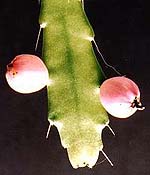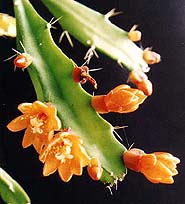

|
Key to the subspecies
1.Stem-segments angled or flattened, spines l-2 or more, pericarpel
angled, often spiny
subsp. monacantha
- Stem-segments flattened, spines absent, pericarpel not spiny. subsp.
kimnachii
(Doweld) Ralf Bauer in Cactaceae Syst. Init. 19: 8. 2005.
= Acanthorhipsalis monacantha subsp. kimnachii Doweld in Sukkulenty
4(1-2): 41. 2001- publ. 2002.
Replaced synonym:
Rhipsalis monacantha var. espinosa Kimnach in Cact. Succ. J. (Los Angeles)
67(1): 38. 1995. Holotype: Bolivia, dept. Cochabamba, road from Cochabamba-Chapare
highway to Tablas, 1974, Aguilar s.n. in Kimnach 2757, cult. Huntington
Bot. Gard. 51587 (HNT), isotypes: HEID, US.
Pfeiffera monacantha (Grisebach)Heath Calyx, 4(4); 158. 1994 see Hunt
in Cact. Syst. Init. 14: 2002
Lepismium monacanthum (Grisebach) Barthlott in Bradleya 5 (1987)
Desc from B&R 1923 & CSJ(US) p38 (1995)
Body - mostly pendant;
Stems - 2 - 3cm broad, to 45 cm long, flat or 3-angled, serrate;
Areole - to 1.2cm apart;
Spines - 1-6, to 1 cm long., also a few bristles;
Flowers - to 1.5 cm long, waxy orange, with small scales and felt; (Note
that Britton and Rose show these incorrectly as white)
Fruit - spherical, to 1 cm ?, orange at first, then orange-red or paler,
scaly;
Seeds - . dark brown.
DISTRIBUTION Bolivia (Cochabamba, Santa Cruz, Tarija), Argentina (Jujuy,
Salta): at 300 - 2000 m altitude.
From Bradleya 13
Kimnach’s recently published description of a new variety espinosa
[Cact. Succ. J (US) 67: 37 - 39 (1995)] has highlighted the diversity
within this species, but the decision as to whether sub-species should
be recognised must await further studies in the field.
Previous Page |